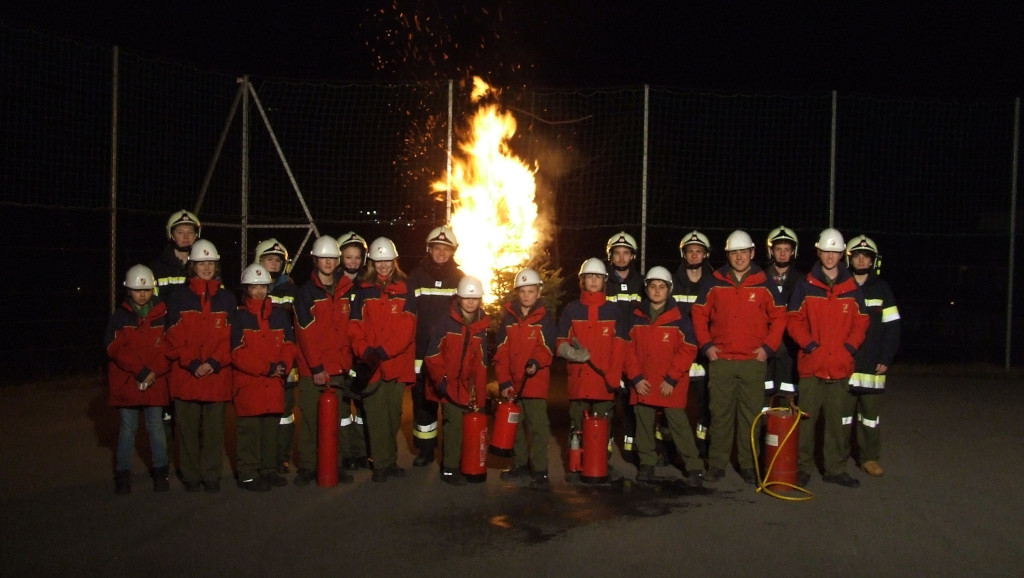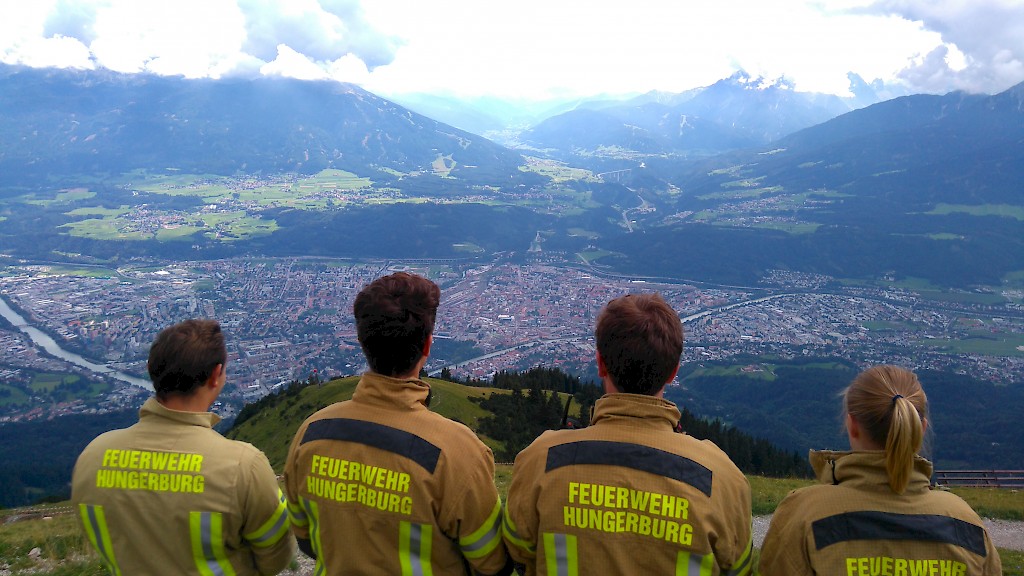How my firefighter experience influenced my leadership style as an engineering manager
12 min read
— This article is not only for managers! read why…
I joined the youth group of our small local volunteer fire department in the neighbourhood when I was 12 years old. As a teenager, I was not aware that the youth instructors applied a very smart mix of fun, training, repetition, and strict commands to transform us from clumsy youngsters to real firefighters. Later, I understood that it wasn’t an easy task. I learned how difficult it is to motivate teenagers and train them when I took over the youth instructor role and slowly got into this business (see picture above of my team of youngsters during a fire extinguisher training). It is a challenge to prepare, train, and guide 11-15 years old boys and girls 4 years long while keeping them motivated until they can finally join the crew of adults who extinguish house fires and rescue cats.
Nothing is more difficult than motivating people
One would think that the action of fighting a fire already motivates volunteer firefighters to join the weekly training in the evening, several multi-day courses every year, and take over responsibilities in the organization and, thus, sacrifice their free time.
I have learned that this is not that easy after I was more involved in the management of the organization and was finally elected as the deputy fire chief of our department after 15 years. It might sound corny, but volunteers don’t follow just because you have a higher rank. You need trust and people have to believe that you can handle an operation. If you give the command to enter a burning house, people will only follow your commands if they trust you (and if it makes sense).
If you give an order that people have to show up at the training next week, they won’t. They don’t have to. It is not the army, it is not their job, they will find excuses and will slowly fade out from the organization. I have experienced hard times when our crew of active people has shrunk from 50 to 20 people.
Team of youngsters at a fire extinguisher training during my time as youth instructor
They should be proud to work for us!
Engineers work almost voluntarily for you. They earn a lot of money but as they work for you, they are really good I guess ;) and they will find another good job immediately. Thus, money isn’t a motivator for a longer period of time and you have to keep them motivated. I already heard CEOs say: they should be proud to work for us. In the long run that even doesn’t work for the Big Five, so I assume, it won’t work for you either.
I figured that the dynamics of engineers and volunteer firefighter teams are very similar, maybe it applies even for all kinds of teams. In this post I have summarized my top five lessons learned from my time in the fire department and how it helped me to shape my leadership style as an engineering manager.
Lesson 1: Provide structure and keep going
Especially when the motivation in the team is already down, for a lead, it is super hard to keep going. But this is exactly the most important phase and it is crucial to have a lead who does not give up. For a team in this downwards spiral, the most important thing is structure.
In the fire department, when the team got smaller and smaller due to a lack of motivation, we made a big mistake: We canceled some of the weekly drills as the group of present people was too small to practise bigger operations—or at least that was the excuse. As a result, even more people got bored and dropped out.
I saw similar situations in engineering teams when the motivation was down. People got more and more passive and they no longer proposed to catch up, to have brainstorming sessions, or to talk with each other to find the best solution for a problem.
In this situation it is essential to insist on the routine that you have hopefully already established before you experience difficult times. Do not accept cancellation requests for 1:1 sessions, retrospectives, or other regular meetings. In this dangerous situation, as a lead, you are the tower of strength and you can help the team to overcome the situation. It sounds quite easy but in reality it is not. In such situations I was depressed and unmotivated as well.
Everybody works differently but I think a piece of general advice is to stabilize yourself first. Do something outside of your job that makes you happy. Approach your allies (in private or business) and discuss the situation to be able to digest it faster. After that, support the team and keep the routine going. For the weekly firefighter drills I prepared backup plans in case too few people showed up. It is always good to have backup plans to be prepared and keep the system going. For 1:1s, you can try to bring some variety to it by e.g. asking different and new questions.

We do regular trainings such as Flash-over container trainings to be prepared for the real fire
Lesson 2: Celebrate them!
Celebrate your team and celebrate with the team. I mention it here explicitly because I forgot it too often. Especially as a lead your rhythm is not always synced with the team. It happened regularly to me that during the last phase of a project I was already snowed under with organizational tasks for the next project.
A simple “thank you” might be enough, or sometimes a big party together with the team is called for. When the team has accomplished something and can move on to the well-deserved resting time, the lead should think about the celebration and how she can thank people. Firefighters sacrifice their free time and join training events while they could spend time with their families, friends, or just enjoy their free time in another way.
Our fire department is in a higher region in the mountains in Innsbruck in Austria and it happened several times that the team was on duty for several days during natural disasters in winter (snow) and summer (floodings). It is not a big deal to invite over friends and family to a small dinner party in the fire department but you show the appreciation of all the people involved.
Saying thank you is crucial, not only because we rely on the younger generation in our fire department.
Your development team might also run into similar exhausting situations. They do over-hours for several weeks to meet a deadline or just work very hard because they believe in the project. This is not the norm and you should thank them. There are many ways of saying “thank you”, and it can range from thanks you deliver in a 1:1 meeting to a bigger team event activity outside of your daily work environment. For me, it is always important that it is an honest “thank you” and that it is not just two words. Again, they could also spend their time in a different way and also other companies pay their employees, that is not unique to you.
Lesson 3: Know your people and support their development
It sounds obvious, but do you know your people? Can you answer the following questions for every team member?
- What are the three biggest strengths of the team member?
- What are the motivational factors of the person?
- What non-job-related interests does this person have?
In our fire department we need people who take responsibility over the IT system, fire trucks, equipment & tools maintenance, operational uniforms, and a lot of other areas. When entering a burning house you better know that the maintenance of tools and equipment was done in a proper way. It is not sufficient to just distribute the responsibilities, you have to know about the passion of people and if they really want to do it. Furthermore, you have to judge if they can and want to learn everything they need to know to take over a responsibility area.

Going beyond personal limits during self-rescue training, abseiling on the wall of a building.
In a company or team you also find a variety of different tasks that have to be done. Especially in smaller companies you do not have specialists for every single area. This can be a burden but also an opportunity for people to not only do their main job and get bored. Some people like to do other things from time to time and also learn new things.
A good example is recruiting. Not everybody wants to do it and not everybody is suited for it. You have to know your people and sometimes, also push them a bit to take on new challenges. Some people underestimate themselves very often and think they do not know enough to take on a new challenge. It doesn’t matter if it is about taking the tech lead role of a new project, recruiting, or switching from an individual contributor role to a manager role. When you know people, their skills and interests, you can judge better if they are capable of doing it and you can help or motivate them to find new challenges and develop their skills.
Lesson 4: Say yes!
There are tons of leadership articles out there that state saying no is crucial. In a lot of situations that might be true but I disagree with them when it is about company or team culture. Think about yourself and how you feel when approaching somebody with a suggestion and then you get the reply “no” or the more or less equivalent “yes, but…”. I call those phrases motivational killers and using it leads to frustrated team members.
Saying yes doesn’t mean that you have to accept or like everything. For example, the answer “Yes, that sounds like a feasible idea. How would you implement it?” doesn’t mean that you agreed with it. You can ask more questions and analyze the proposal together with the team member. In the worst case, by answering your questions, the person realizes that there might be some issues with the idea. In the best case, it is worth working on it and there is already a team member who buys in and wants to work on this project.
I heard a lot of ideas from really young firefighters who proposed new ways of training or super cool training objects like old dry Christmas trees (see image at the beginning of the article). Sometimes, especially with more senior people, a “yes, great idea” as a supporting sign from the lead can be already sufficient. In case the person needs more guidance, it is the job of the lead to provide it and also follow up on it to bring the project to an end.

Pragmatic way proposed by a team member to clear the blocked street from fallen rocks
Following this positive “say yes” attitude, you will end up with a lot of ideas and in my opinion, it is also one of the main ingredients for a prosperous innovation culture in your team. One developer once proposed a weekly sharing meeting under the motto “I learned this cool thing this week” and later also drove and organized the very successful meeting. This initiative provided structure (lesson 1), and supported people to learn new things (lesson 3). The thank you (lesson 2), was not only given by myself but also by several other team members. I did nothing but saying “yes, cool idea, let’s try it out”. You don’t have to invent everything on your own, it is always a team effort.
Lesson 5: Happiness will lead to growth
All previously mentioned points influence it, the most important key performance indicator (KPI) of your team, the team’s happiness. It is a fluffy term and it is difficult to measure, nevertheless, for team leads, it should be on top of their priority list. I do not want to go into detail here as happiness covers almost all people topics somehow but I want to mention two important factors for happiness. In my opinion, good developers want to be challenged and want to learn, so you should boost those two factors by shaping the environment to make it possible.

When our fire department suffered from a high dropout rate, we distributed most responsibilities to active people, gave them new challenges and tried to keep going with the remaining people. Combined with the all-time awesome team atmosphere, we grew after a short period of time just due to the word of mouth. People heard that it is fun to join the fire department, you can learn a lot of new and meaningful things, and it is a great open-minded group.
I experienced the same situation in a company again when we opened some positions in a well-functioning team. Several people in the same company directly approached me and applied for the position internally as they heard a lot of good things about our team. So in case you have recruiting problems, make your team happy and let them grow. This might be a very time consuming and a big investment in your team, but eventually, it will pay off.
Conclusion
I was twelve when I joined the fire department and I am still a member of the team after more than 25 years. I still like the diverse team, the atmosphere, and whenever I am in my home town I join drills and learn new things from people who were in the team of youngsters I trained 15 years ago. Clearly you cannot boil down the work of an engineering manager to one aspect but in my opinion replicating this type of culture that enables people to learn and grow in a friendly and professional environment is key in leadership. And don’t forget to say thank you. Thanks for reading.

Not only for managers
This article is not only for managers! It is very important to me to mention that everybody can contribute in those fields, even without a lead/manager role. In all mentioned situations I was not on my own and a lot of ideas and changes were driven by “non-managers”. So please, propose ideas and drive projects, even if you do not wear the official “manager” or “lead” hat. I can strongly recommend reading the article Leadership as an Individual Contributor by Tom Bartel. back to the top ↑
Book recommendation
For a long time I was wondering if a bottom-up leadership style, which is more common in the modern IT world would also work in a very hierarchical traditional environment, such as the world of firefighters or military. I know it was possible in our small volunteer fire department but I also knew other fire departments where the hierarchical leadership approach was very common. I saw our department more like an exception and I was not sure if such a leadership style would work in a professional fire department with paid firefighters.
Later when I was working for trivago, I read the book Turn The Ship Around! by L. David Marquet and I found out that apparently it can work in such an environment. The book is written by a commander of a nuclear-powered submarine in the navy who explains how he applied the bottom-up leadership style which empowers people in this traditionally very hierarchical environment.
The book covers a lot of aspects of how to lead while empowering people to take responsibility for themselves and to grow in their roles. I can strongly recommend this book to any lead and especially engineering managers. At the end the difference between navy specialists and IT specialists might be smaller than expected ;)
Comments & Discussion
- Comments/Upvote on Hacker News
- Feedback (anonymous) via Constructeev
Credits
- Thanks a lot to Christof Schlenz, my friend, youth instructor, and later fire chief of our fire department who showed me how to lead without “authority by hierarchy”.
- Thanks to Andy Grunwald and Min Fang for reviewing drafts of this article.